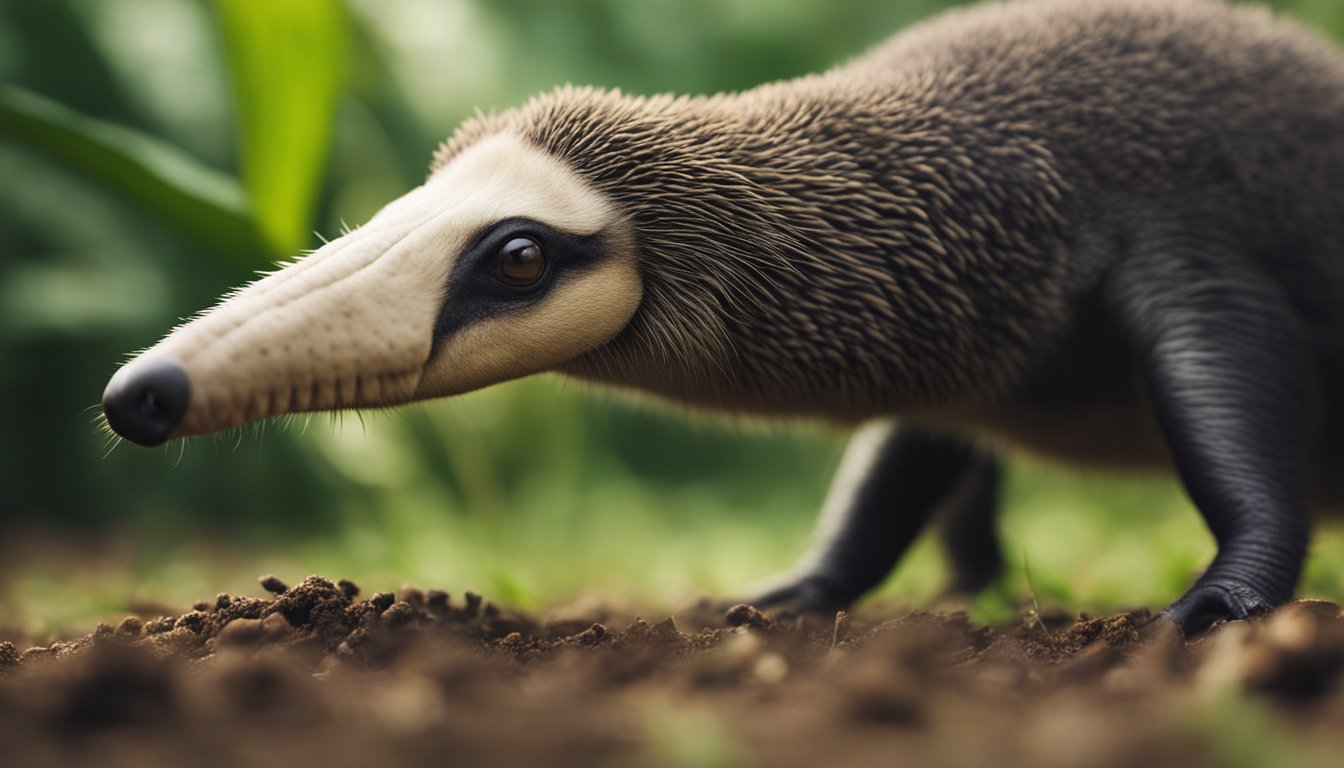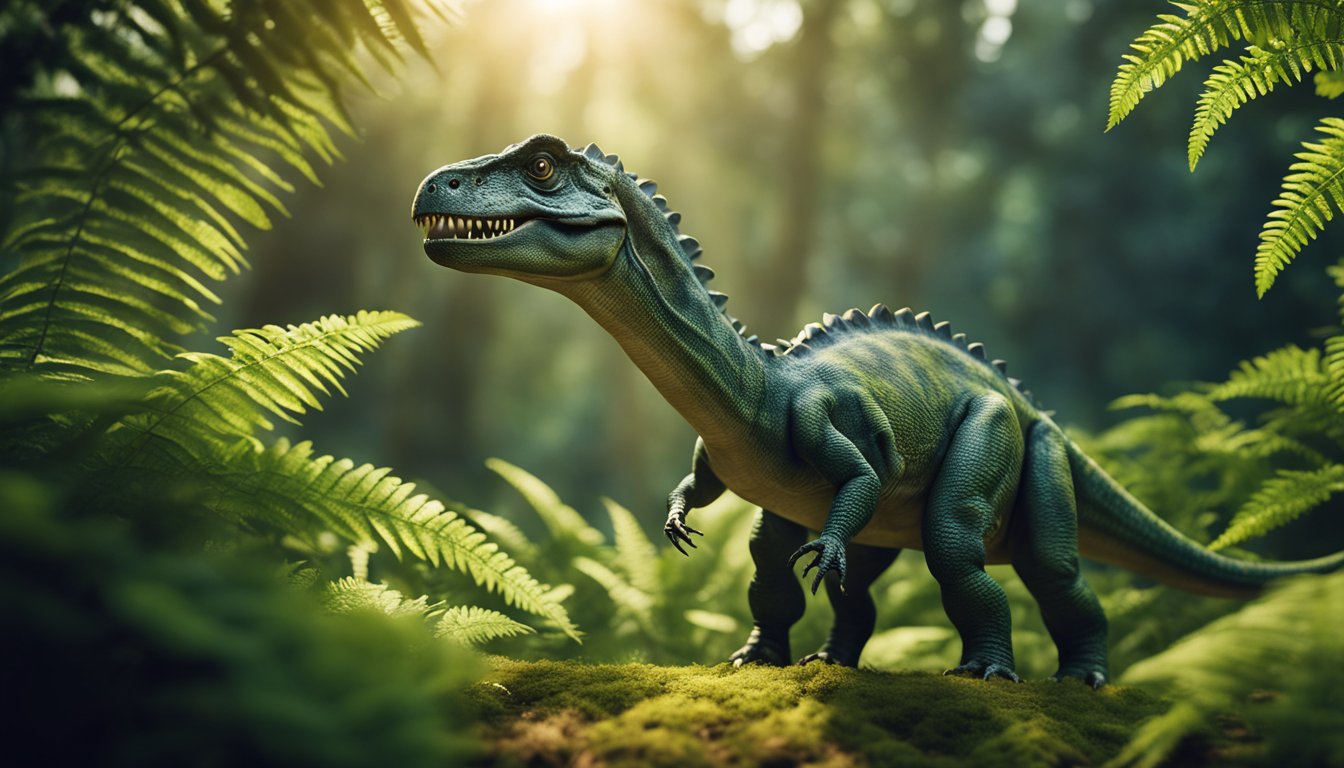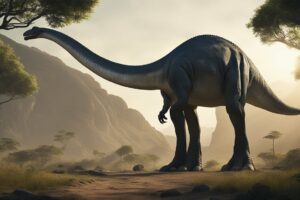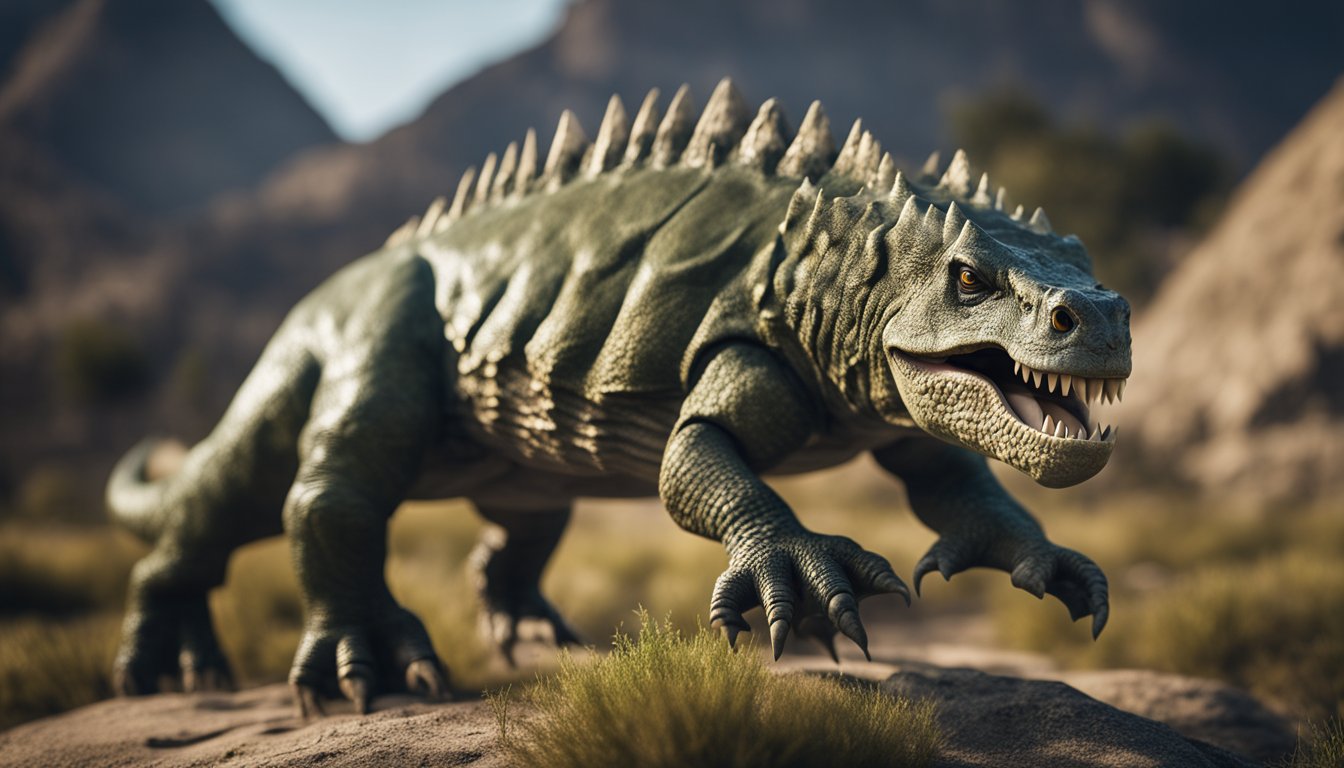Fruitafossor, a prehistoric animal that lived during the Upper Jurassic epoch, about 150 million years ago, is a fascinating creature that has captured the imagination of scientists and animal enthusiasts alike.
It was a small, chipmunk-sized mammal that looked like an armadillo or anteater and probably ate termites in much the same way these animals do today.
The discovery of a surprisingly complete skeleton of Fruitafossor in Fruita, Colorado, in 2005, has provided valuable insights into the evolution and behavior of this ancient animal.

Fruitafossor’s skeletal features clearly show that it was not related to armadillos, anteaters, or any modern group of mammal.
Its teeth were sharp and lacked enamel, suggesting that they were lost and replaced as they wore out.
This is a common feature in animals that eat termites since they usually do not have to do any chewing.
The same type of teeth is found in mammals that primarily feed on termites.
Other skeletal features indicate that Fruitafossor was well adapted for digging and had powerful forelimbs that it used to dig for food and shelter.
These adaptations suggest that Fruitafossor was a fossorial animal, which means that it lived and burrowed underground, much like modern-day moles.
Discovering Fruitafossor Windscheffeli

Fruitafossor windscheffeli, a termite-eating mammal that lived during the Late Jurassic epoch, was discovered on March 31, 2005, in Fruita, Colorado.
The discovery of a complete skeleton of the chipmunk-sized animal was a significant achievement for paleontologists studying the Morrison Formation.
Unearthing the Past in Fruita, Colorado
The discovery of Fruitafossor windscheffeli was made by Charles E. Safris of Des Moines, Iowa, and Wally Windscheffel, a volunteer at the Carnegie Museum of Natural History.
While exploring the Morrison Formation near Fruita, Colorado, they stumbled upon a remarkably well-preserved skeleton of an animal that looked like an armadillo or an anteater.
The site where the fossil was found is now known as the “Fruitafossor Site,” and it has since become a popular destination for paleontologists and fossil enthusiasts from around the world.
The discovery of Fruitafossor windscheffeli has shed new light on the evolution of early mammals and their adaptation to different environments.
The Significance of a Complete Skeleton
The discovery of a complete skeleton of Fruitafossor windscheffeli was a significant achievement for paleontologists.
Complete skeletons of prehistoric animals are rare, and they provide valuable information about the animal’s anatomy, behavior, and ecology.
The skeleton of Fruitafossor windscheffeli was almost 40% complete, including the forelimb, manus, hindlimb, hindfoot, and most of the thoracic, lumbar, sacral, and caudal vertebrae.
The discovery of Fruitafossor windscheffeli has helped paleontologists better understand the diversity of early mammals and their adaptation to different environments.
The animal’s diet of termites was unusual for a mammal of its time, and it has raised questions about the evolution of insectivorous mammals.
The discovery of Fruitafossor windscheffeli has also helped paleontologists better understand the Late Jurassic ecosystem and the role that mammals played in it.
Anatomy of a Digging Mammal

Fruitafossor windscheffeli was a termite-eating mammal that lived during the Late Jurassic epoch, around 150 million years ago, in what is now North America.
This small, chipmunk-sized animal had unique skeletal features that made it a highly specialized digging mammal.
Specialized Teeth and Diet
One of the most striking features of Fruitafossor was its peg-like teeth, which were similar to those of xenarthrous placental mammals like armadillos and anteaters.
These specialized teeth were adapted for myrmecophagy, or feeding on ants, which was likely the primary source of food for Fruitafossor.
Adaptations for Life Underground
Fruitafossor had several adaptations for a fossorial, or underground, lifestyle.
Its forelimbs were short and robust, with strong muscles that would have allowed it to scratch-dig through the soil.
Its vertebral column had a xenarthrous process, which allowed for greater flexibility and strength for digging.
Fruitafossor’s skeletal features also suggest that it was well-adapted for life underground.
Its vertebrae were fused together, which would have provided additional stability and support for digging.
Its ribcage was also highly modified, with broad and flat ribs that would have protected its vital organs while digging.
Overall, Fruitafossor was a unique and fascinating example of a digging mammal from the Late Jurassic epoch.
Its specialized teeth and adaptations for life underground make it a fascinating subject for paleontologists and animal enthusiasts alike.
The Ecological Niche of Fruitafossor

Coexisting with Dinosaurs
Fruitafossor lived during the Late Jurassic epoch, a time when dinosaurs roamed the earth.
It was a small, chipmunk-sized mammal that was well adapted to its environment.
Despite its small size, Fruitafossor was a formidable hunter of termites and other insects.
It had sharp teeth that were constantly replaced, allowing it to eat without the need for chewing.
This adaptation was particularly useful for an animal that ate termites, which do not require much chewing.
Fruitafossor coexisted with a variety of dinosaurs, including the stegosaurs and sauropods.
It is believed that Fruitafossor was a nocturnal animal, which may have helped it avoid these large predators.
It was also a proficient digger, with strong claws that enabled it to quickly break down termite hills or dig out a hole when escaping a predator.
A Unique Place in the Food Web
Fruitafossor played a unique role in the ecosystem of the Late Jurassic.
It was one of the few mammals that lived during this time, and its diet of termites and other insects set it apart from the dinosaurs and other reptiles that dominated the landscape.
Fruitafossor’s ability to eat termites, which are colonial insects, allowed it to exploit a food source that was not available to other animals.
This gave Fruitafossor a unique place in the food web.
Fruitafossor’s role in the ecosystem was short-lived.
It lived during a time of great change in the Mesozoic era, when the dinosaurs and other reptiles were dominant.
However, it was also a time of early mammalian diversification, and Fruitafossor was one of the first mammals to evolve during this period.
The extinction of the dinosaurs at the end of the Cretaceous period allowed mammals to diversify and eventually become the dominant group of animals on earth.
Fun Fact: Did you know that Fruitafossor was discovered relatively recently, in 2005? It was found in Fruita, Colorado, which is where it gets its name.
Fruitafossor’s Legacy in Mammalian Evolution

Fruitafossor, a prehistoric termite-eating mammal that lived during the Upper Jurassic epoch, has a significant place in the history of mammalian evolution.
Its discovery in 2005 in Fruita, Colorado, shed new light on the early evolution of mammals.
In this section, we will explore Fruitafossor’s impact on mammalian evolution, including how it connects past and present and its influence on modern mammals.
Connecting Past and Present
Fruitafossor’s discovery was a game-changer for paleontologists studying early mammals.
Until then, the earliest known digging mammals were from the Cenozoic era, which began around 66 million years ago.
Fruitafossor’s existence pushed back the timeline for mammalian diggers by over 100 million years, opening up new avenues of research into early mammalian behavior and classification.
Fruitafossor’s skeletal structure also revealed important clues about the evolution of modern groups of mammals.
Its teeth and arms resembled those of modern anteaters and armadillos, which belong to the order Xenarthra.
This discovery helped scientists link early mammals like Fruitafossor to modern Xenarthrans, providing a better understanding of mammalian evolution.
Influence on Modern Mammals
Fruitafossor’s impact on modern mammals can be seen in its resemblance to other modern groups of mammals.
For example, its long snout and tubular teeth are similar to those of modern numbat, pangolins, and echidnas, which are all insectivores.
Additionally, its small size and insectivorous diet make it comparable to modern sloths, which are also omnivores.
Fruitafossor’s discovery also provided insight into the evolution of modern marsupials.
Repenomamus and Castorocauda, two early mammals that lived during the Mesozoic era, were found to have similar teeth structures to Fruitafossor.
This discovery helped scientists classify these early mammals as therians, a group of mammals that includes marsupials and placental mammals.
In conclusion, Fruitafossor’s discovery has had a significant impact on our understanding of mammalian evolution.
Its connection to modern groups of mammals and its influence on early mammals like Repenomamus and Castorocauda provide important clues about the classification and behavior of early mammals.
The discovery of Fruitafossor has opened up new avenues of research and helped paleontologists fill in gaps in our understanding of mammalian evolution.
Frequently Asked Questions

What kind of diet did Fruitafossor have, and how does it compare to modern anteaters?
Fruitafossor, the prehistoric animal that ate like an anteater, had a unique diet.
It is believed that Fruitafossor fed on termites, which were abundant during the time it lived.
This diet is similar to modern-day anteaters, which feed mainly on ants and termites.
However, the main difference between Fruitafossor and modern-day anteaters is that Fruitafossor did not have the long, sticky tongue that modern-day anteaters use to catch their prey.
Instead, Fruitafossor had strong front limbs that it used to dig into the ground and extract its food.
Can you describe the habitat in which Fruitafossor once lived?
Fruitafossor lived during the Late Cretaceous period, around 100 million years ago. During this time, the Earth looked very different than it does today.
Fruitafossor lived in a lush, tropical environment, which was home to a diverse range of plant and animal species.
The area where Fruitafossor was found was once a floodplain, which was covered in dense vegetation.
How did Fruitafossor contribute to our understanding of prehistoric mammal diversity?
Fruitafossor is an important discovery because it challenges our understanding of prehistoric mammal diversity.
Before Fruitafossor was discovered, it was thought that the earliest mammalian diggers lived during the Cenozoic era, around 66 million years ago.
However, Fruitafossor lived during the Late Cretaceous period, around 100 million years ago.
This means that Fruitafossor existed 34 million years before the previously known Cenozoic ancestors of today’s mammalian diggers.
Fruitafossor’s discovery has helped scientists understand that the evolution of mammalian diggers is more complex than previously thought.
What are some distinctive physical features of Fruitafossor?
Fruitafossor had several distinctive physical features that set it apart from other prehistoric animals.
One of its most notable features was its strong front limbs, which it used to dig into the ground and extract its food.
Fruitafossor also had a long, narrow snout, which suggests that it had a good sense of smell.
Its teeth were small and pointed, which suggests that it was an insectivore.
Fruitafossor’s skeletal structure also suggests that it was a fast runner and had good balance.
In what ways did mammals like Fruitafossor adapt to their environment?
Mammals like Fruitafossor adapted to their environment in several ways. One of the most important adaptations was their ability to dig.
By digging into the ground, mammals like Fruitafossor were able to find food and shelter.
They also evolved strong front limbs and sharp claws, which helped them dig more efficiently.
Mammals like Fruitafossor also evolved a keen sense of smell, which helped them locate their prey.
Finally, they evolved a fast running speed and good balance, which helped them escape from predators.
What evidence do scientists use to study extinct animals such as Fruitafossor?
Scientists use several different types of evidence to study extinct animals such as Fruitafossor. One of the most important types of evidence is fossils.
Fossils are the remains of plants and animals that have been preserved in the Earth’s crust.
By studying fossils, scientists can learn about the physical characteristics of extinct animals, as well as their behavior and environment.
Scientists also use DNA analysis to study extinct animals.
By analyzing the DNA of fossils, scientists can learn about the genetic makeup of extinct animals and how they are related to modern-day species.
Finally, scientists use computer models to simulate the behavior of extinct animals.
By using computer models, scientists can learn about how extinct animals moved, hunted, and interacted with their environment.





